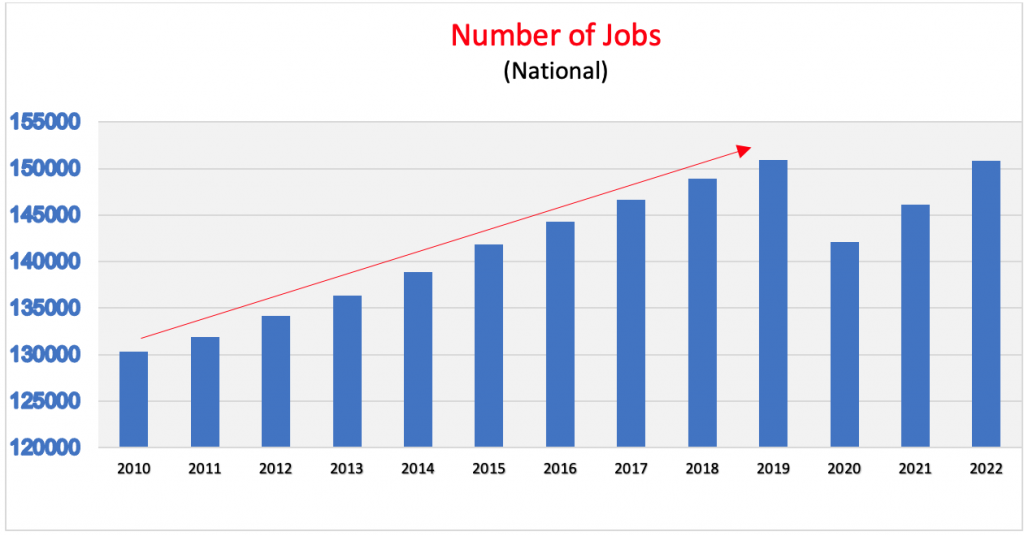The Vanishing Workforce
Labor Trends You Need to Know
By Gerry Hoeffner
Long waits for sit-down service at a restaurant where half of the tables are empty; stores adding more and more self-checkout stations; the constant replanning business must do because they just can’t get the goods and services they need to run their operations. Why? Because in every aspect of our daily lives, we see significant changes in the market due to worker shortages.
The accepted explanation for the shortage is that it is a continued effect of COVID. With that explanation comes the logical expectation that the inconvenience will be temporary, and soon we will all return to “normal”. Mark Twain said, “It ain’t what you don’t know that gets you into trouble, it’s what you know that just ain’t so.” Regretfully, the demographic statistics suggest the worker shortage is only a temporary inconvenience of Covid “just ain’t so.”
The ratio of available workers to open positions has been steadily declining since 2009, not since Covid, but since 2009. In 2009, there were approximately 6 available workers (both employed and unemployed) for every open job position. In 2022, that number has precariously fallen to 0.5 workers per open position. In 2019, before Covid, the number was only slightly better at 0.75. These numbers indicate 1) the situation is grave; 2) Covid is not the culprit; and 3) the long-term, thirteen-year trend suggests it is not going away any time soon.

In addition to population growth, there is what some call “progress” and others call “affluence”. Think about life 22 ago. The year is 2002. Consider all of the inventions and services that did not exist at that time: smart phones and watches, drones, movie streaming, gyms and nail salons on almost every street corner, delivery of any item directly to your door, a myriad of fast-food restaurants of every ethnic diversity, social media, and the list goes on. Those services require jobs and jobs require bodies. That is the problem. As we increase these services, as we increase these inventions. As we increase our gadgets and leisure activities, we increase the need for jobs. We increase the need for bodies.
Bottom line is we are increasing the need for jobs, while at the same time decreasing our production of bodies. Something must give.

Probability suggests it is the employer who will have to give. There have certainly been times, especially during periods of low unemployment, when employees were in a similar favorable position, but those times were not long-lived and the pendulum swung back to the employer relatively quickly. It’s different this time because those prior periods of employee advantage and high job growth were not accompanied by low population growth.
This time looks different for another reason. Workers today, regardless of their age, are markedly different and the workplace is different. Due to the internet and social media, today’s workers are no longer isolated. They are more familiar with workplace practices, benefits, and salaries. They are now not only able, but do communicate with others outside of their own workplace. The unknown, which is a major impediment to change, is no longer unknown to them. They are therefore more willing to embrace change, and that change could be from your workplace to a different one. Because they are knowledgeable of what alternatives exist beyond their current workplace, they are more willing to take the leap to what they consider to be a more positive, more promising alternative. Given this, how important is it for any employer to know how their workplace is being considered as an alternative. Are your organization’s employees describing your workplace in a manner that will attract workers to it or is it the opposite? Is your workplace being branded in a manner that will maintain and attract the employee you seek? It is more than are they engaged, you must question, how are they marketing you?
They are many alternatives that workers are discovering. The options are many. You need to understand that as the employer or the HR professional, you are at a disadvantage. Remember that for every job position, there is currently only 0.5 available employees.
Some suggestions:
- Brand and market your workplace. Your community and your industry need to know what is great about your culture. What you are known for? Human Resources and Hiring Managers should focus on selling why someone would want to work for your organization. In order to sell working for you, you will have to quickly identify what an applicant is looking for, and then sell them on how your work environment can meet those needs. Not everyone is looking for the traditional benefits. You need to have those just be competitive. What is it about your organization that no one else in your community can say?
- Expedite and modernize recruiting. The days of gathering 20 or 30 applications for review and consideration are gone. By the time you have done your gathering, the better employees will have been hired by a competing employer. Streamline your hiring procedures. Also, be quickly responsive. You have probably less than 12 hours to connect with a talented applicant before some other company has already contacted them. When you receive an application or inquiry, engage the applicant as soon as possible to let them know of your interest in them. In much the same way a college coach entices and tries to “wow” a potential recruit, court your potential new employee with multiple, timely contacts. Be certain your recruiting practice has the “wow” factor.
- Embrace change and be prepared to change quickly if you have too. Covid is an excellent example of how quickly your organizations can change. Change the cultural mismatches of your organization to the desired culture you wish to create and change them quickly. Due to the internet and social media, today’s employees are markedly more informed of workplace practices. It is your job to fix that which is what does not work and create a culture that does work.
- Don’t be static. Analyze your organization frequently, particularly your employee turnover since this factor is an excellent indicator of your organization’s health and your employees’ job satisfaction. Employee satisfaction goes hand in hand with customer satisfaction. Employee turnover has tremendous costs, too many of which go unrealized. As noted, it impacts customer satisfaction, but also every hour spent in hiring and training new staff is time which could be spent productively serving customers or improving the organization. How much does turnover cost? Find out by going to turnovercalculator.com.
- Commit to being an exceptional employer. What do you seek from every employee? The answer: For each of them to be exceptional. Can you imagine how successful your organization would be if you only had exceptional employees? Remember, the pendulum has swung and the employee now has advantage and it is the employee who expects the employer to be exceptional. Why not form a team or a partnership and be exceptional together in whatever way both decide can be achieved? And while you’re doing that, brand yourself and market your culture. Let the community know that your organization is a Great Place to Work. If your workplace culture is exceptional, so also will be your work product. Commit to making your culture so exceptional that is sells your organization and your product.
Above all else: really, really care. I recently consulted with an employer who operated a small, fast-food restaurant that had no significant employee turnover. When I asked the owner how he accomplished this, his response was “I listen.” He went on to explain that every day, he made himself available to his employees so that they could speak with him, and they did. They spoke with him not only about work, but their school, their family, their girlfriend or boyfriend, their goals and plans, recreational activities, God, current events, sports, and their problems and concerns. He noted he became the father many of them never had. He cared and they returned that care by being loyal to him.

Gerry Hoeffner is President of Personnel Dynamics Consulting. Gerry works with organizations throughout the country creating effective work cultures, improving productivity, and – most importantly – developing leaders for today’s workforce. He is known throughout the U.S. for his high-energy presentations, humor and a “straight talking” approach to management. He is eager to speak at chapter events throughout the state.